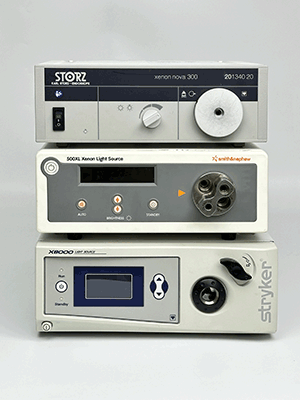Tel: +86-19906868508
E-mail: info@sihanmed.com
Tel: +86-19906868508
E-mail: info@sihanmed.com

At present, light sources are widely used in the medical field. Scientific and rational use, as well as proper maintenance and repair of cold light sources, play a vital role in ensuring their extended service life and maximizing the efficiency of clinical use.
Light sources, with their unique nature, find widespread application in medical lighting. They are used to illuminate medical equipment, including flexible endoscopes and rigid endoscopes. Flexible endoscopes are employed in the examination of the gastrointestinal tract and ear, nose, and throat. On the other hand, rigid endoscopes are typically used in operating rooms for procedures such as laparoscopy or hysteroscopy.
The 300 W xenon lamp has a color temperature of about 6,000 K, which allows you to achieve exceptionally bright illumination. Xenon lamps can be instantly energized to full light, a mechanism that helps to avoid the instabilities typically associated with arches and extends the life of xenon lamps.
Xenon lamp bulbs contain inert gas (xenon gas). When the cold endoscopy light source starts working, the ignition circuit applies a triggering pulse voltage of tens of thousands of volts to both ends of the xenon lamp, triggering and penetrating the xenon gas. This results in high-density arc discharge at both ends of the xenon lamp, producing intense flashes. Simultaneously, the energy storage capacitor parallel to the xenon lamp discharges to maintain the xenon lamp's illumination, while the ignition circuit ceases operation. When the capacitor voltage drops to a certain level, the main circuit starts working, putting the xenon lamp into an arc discharge state.
Xenon lamp bulbs have characteristics such as high power and high temperature, and the light they emit has a high color temperature and heat. Such light can not only cause burns to operators or patients but may also damage optical paths, endoscopes, or imaging systems. Therefore, direct exposure to the human body is not advisable. Before the light emitted by xenon lamp bulbs enters the human body, it must first pass through a non-spherical reflector to filter out thermal energy. This process involves vacuum coating the inner surface of the reflector with multiple layers of dielectric film (such as repeated use of zinc sulfide, magnesium fluoride, etc., for vacuum coating). When the coating reaches a certain thickness, the infrared rays projected onto the non-spherical reflector are absorbed, preventing them from focusing and conducting to the fiber optic pathway, thus achieving the goal of creating cold light.
The cooling system is an essential component of the cold light source, consisting of a fan, heat sink, and reflector hood. During operation, the reflector hood absorbs thermal energy from the light source, while the fan and heat sink are employed for the cooling of high-power components.
This is the first one.